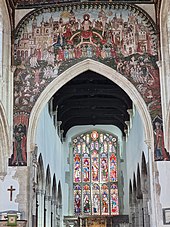St Thomas's Church, Salisbury
| St Thomas's Church | |
|---|---|
Saint Thomas of Canterbury | |
| Architecture | |
| Functional status | Active |
| Years built | Founded 1220, rebuilt 15th century |
| Administration | |
| Province | Canterbury |
| Diocese | Salisbury |
| Archdeaconry | Sarum |
| Deanery | Salisbury |
| Parish | Salisbury St Thomas and St Edmund |
Listed Building – Grade I | |
| Reference no. | 1273123 |
St Thomas's Church is a
Location
St Thomas's Church stands just west of the city's market place. The street leading from the north gate of the cathedral close to St Thomas's churchyard was laid out when the cathedral was built in the 13th century, and gained the name High Street in the 14th century.[1]
History and architecture

The first church on the site is thought to be a small wooden chapel built c.1219 by
The tower, with porch below, was added on the south side of the church in the early years of the 15th century. Construction of a stone spire was abandoned when the tower began to lean, and instead the tower was capped later that century, by a pyramid roof and battlements.[5] There are eight bells, the oldest cast by Abraham Rudhall in 1716, and the others by Robert Wells of Aldbourne in 1771.[6]
In 1447 the
In the 1470s, the nave arcades were replaced, the aisles rebuilt and a clerestory added under a new roof. The resulting nave is called "wonderfully light" by Julian Orbach.[5] The 15th-century roofs are embellished with carving and many figures of angels; Orbach calls the nave roof "ornate and dainty". The great west window is from the same period.[5][3] The whole has a footprint of 1147 square metres, placing it among the largest churches in Wiltshire.[7]
The tower has an east-facing clock, with a pair of
Interior

Nikolaus Pevsner called the interior of the church "sumptuous".[8]
Above the chancel arch is a large 15th-century doom painting, "one of the best surviving" according to Orbach, which depicts Jesus and the twelve apostles above portrayals of heaven and hell. The painting was hidden below whitewash in 1593 during the Reformation. It was uncovered in 1881 and the paint was heavily retouched by Clayton and Bell.[3] The painting has since been further restored, most recently in 2019.[9]
In 1850–1860 the tall boxed pews were removed from the chancel, and the high altar and oak screens added. The window above the altar, depicting early Christian figures, was renewed in 1856.
The striking oak altar in the nave, by Matthew Burt, was installed in 2020.[10]
A new organ was bought for the church around 1568[4] and replaced in 1739.[11] The Samuel Green organ which had been presented to the cathedral by George III in 1792 was transferred to the church in 1877.[12] It was restored and enlarged in 1897, and its most recent complete restoration was in 2020.[13]
Parish
When a parish was created for the newly founded
There has long been a link between the church and the
When St Edmund's Church was declared redundant in 1974, the two benefices and parishes were combined to form the parish of Salisbury St. Thomas and St. Edmund.[15][16]
References
- ^ Crittall, Elizabeth, ed. (1962). "Salisbury: St Thomas's parish". A History of the County of Wiltshire, Volume 6. Victoria County History. University of London. pp. 81–83. Retrieved 21 June 2023 – via British History Online.
- ^ Historic England. "Church of St Thomas (1273123)". National Heritage List for England. Retrieved 21 June 2023.
- ^ a b c d e f g h Maude, Rodney (2018). "A Brief History of St. Thomas's Church" (PDF). St Thomas's Church. Retrieved 21 June 2023.
- ^ a b c d e f g Crittall, Elizabeth, ed. (1962). "Salisbury: Churches". A History of the County of Wiltshire, Volume 6. Victoria County History. University of London. pp. 144–155. Retrieved 21 June 2023 – via British History Online.
- ^ OCLC 1201298091.
- ^ a b "Salisbury, Wiltshire, S Thomas of Canterbury". Dove's Guide for Church Bell Ringers. Retrieved 21 June 2023.
- ^ "Church Heritage Record 634447". The Church of England. Retrieved 25 June 2023.
- ISBN 0-14-0710-26-4.
- ^ Dowson, Thomas (24 February 2022). "The Doom Painting of St Thomas' Church, Salisbury". Archaeology Travel. Retrieved 21 June 2023.
- ^ Burt, Matthew (2020). "St Thomas's Salisbury Nave Altar" (PDF). St Thomas Salisbury. Retrieved 21 June 2023.
- National Pipe Organ Register. British Institute of Organ Studies. Retrieved 25 June 2023.
- ^ "Organ in 1877 [N10317]". National Pipe Organ Register. British Institute of Organ Studies. Retrieved 25 June 2023.
- ^ "2020 restoration [S00132]". National Pipe Organ Register. British Institute of Organ Studies. Retrieved 25 June 2023.
- ^ "Parish: Salisbury St Thomas". Clergy of the Church of England Database. King's College London. Retrieved 23 June 2023.
- ^ "St Thomas's Church, Salisbury". A Church Near You. The Archbishops' Council. Retrieved 23 June 2023.
- ^ "No. 46208". The London Gazette. 12 February 1974. p. 1891.
External links
![]() Media related to St Thomas's church, Salisbury at Wikimedia Commons
Media related to St Thomas's church, Salisbury at Wikimedia Commons
